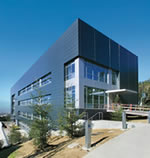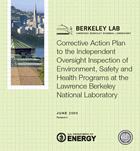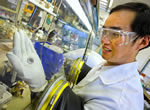


Berkeley Lab's Molecular Foundry is receiving more than $6 million under the American Recovery and Reinvestment Act to advance research in energy and the nanosciences. The majority of the money—$5.9 million—will go towards purchasing four pieces of equipment: a cryo in situ transmission electron microscope, a multi-mode surface analysis system, a computing cluster and a robotic biopolymer purification and analysis system. The computing cluster will meet the new and increasing computational scale of Molecular Foundry Theory Facility user projects, while simultaneously facilitating more than a doubling of the number of projects that the Foundry can accommodate in this area of nanoscience.
A smaller allocation will go towards a collaboration with an Energy Frontier Research Center project at Cornell University on researching new electrodes for fuel cells, batteries, photovoltaics and catalysts. The aim of the project is to better develop new electrodes, based on complex oxide nanostructures, for fuel cells, batteries, solar photovoltaics, and catalysts. This research seeks to develop new oxide-based materials for cheap, efficient and environmentally benign energy generation, conversion and storage technologies. For details, visit recovery.lbl.gov.
 Following the DOE's Health, Safety and Security (HSS) audit of the Lab earlier this year, the Lab developed a corrective action plan (CAP) to address the 10 major areas of improvement listed in the DOE's report. The CAP was submitted to DOE on June 11 and has been approved by George Malosh, Deputy Director for Field Operations of the DOE Office of Science. The corrective actions will result in improvements in the JHA process, exposure assessment program, and electrical safety training, among other things, and will improve the way ES&H programs are developed and implemented in the near future. Jack Salazar is project manager of the HSS CAP; implementation of the Plan began on July 1. Go here for a full copy of the Plan.
Following the DOE's Health, Safety and Security (HSS) audit of the Lab earlier this year, the Lab developed a corrective action plan (CAP) to address the 10 major areas of improvement listed in the DOE's report. The CAP was submitted to DOE on June 11 and has been approved by George Malosh, Deputy Director for Field Operations of the DOE Office of Science. The corrective actions will result in improvements in the JHA process, exposure assessment program, and electrical safety training, among other things, and will improve the way ES&H programs are developed and implemented in the near future. Jack Salazar is project manager of the HSS CAP; implementation of the Plan began on July 1. Go here for a full copy of the Plan.
 [PopSci.com] The most comprehensive poll to date exploring the American people's relationship with science, conducted by the non-partisan Pew Research group, contacted 2,001 non-scientists and 2,533 scientists. The good news: 74 percent of non-scientists polled think that government investment in basic science pays off in the long run, and 60 percent said that government investment in research plays a crucial role in the advancement of science. The bad news: 84 percent of scientists polled said humans cause climate change, as opposed to 49 percent of the non-scientists polled. More>
[PopSci.com] The most comprehensive poll to date exploring the American people's relationship with science, conducted by the non-partisan Pew Research group, contacted 2,001 non-scientists and 2,533 scientists. The good news: 74 percent of non-scientists polled think that government investment in basic science pays off in the long run, and 60 percent said that government investment in research plays a crucial role in the advancement of science. The bad news: 84 percent of scientists polled said humans cause climate change, as opposed to 49 percent of the non-scientists polled. More>
 In the News: Drive to Make Biofuels Thrive
In the News: Drive to Make Biofuels Thrive[Oakland Tribune] In 10 to 12 years, drivers in the Bay Area and around the country may zoom along powered by fuel made from pecan shells, switchgrass or even poplar trees (pictured) thanks to research at Bay Area universities funded by more than $700 million in grants. Researchers say plant-based fuels nurtured by these efforts could be widely available at the pump in 10 to 12 years at a cost comparable to that of gasoline. "A cotton shirt is pure cellulose," said Chris Somerville, director of the Energy Biosciences Institute, of the myriad possibilities. "You could be giving the shirt off your back someday to power your car." More>
 [LiveScience.com] An innovative sky survey has begun returning images that will be used to detect unprecedented numbers of powerful cosmic explosions—called supernovae—in distant galaxies, and variable brightness stars in our own Milky Way. All of these discoveries will stem from the Palomar Transient Factory (PTF) survey, a collaboration of scientists and engineers from institutions around the world, including the California Institute of Technology, UC Berkeley, Berkeley Lab, Columbia University and others. The survey has already found 40 supernovae and is gearing up to switch to a robotic mode of operation that will allow objects to be discovered nightly without the need for human intervention. More>
[LiveScience.com] An innovative sky survey has begun returning images that will be used to detect unprecedented numbers of powerful cosmic explosions—called supernovae—in distant galaxies, and variable brightness stars in our own Milky Way. All of these discoveries will stem from the Palomar Transient Factory (PTF) survey, a collaboration of scientists and engineers from institutions around the world, including the California Institute of Technology, UC Berkeley, Berkeley Lab, Columbia University and others. The survey has already found 40 supernovae and is gearing up to switch to a robotic mode of operation that will allow objects to be discovered nightly without the need for human intervention. More>
 In the News: Wired Calls the Bevatron the “36-24-36” of Physics
In the News: Wired Calls the Bevatron the “36-24-36” of Physics[Wired] Lawrence Berkeley National Laboratory's Bevatron, built by the Atomic Energy Commission for $9 million in the early '50s, is slowly being demolished in the hills overlooking San Francisco Bay. The Bevatron was a marvel, that, when compared to the rest of the human world drew ridiculous comparisons. For boys of all ages, the Bevatron's stats were the 36-24-36 of physics. Read more here. Physics Today also bids farewell to the Bevatron here.
Users of chemicals and other research supplies are reminded that Alfa Aesar products are available on eBuy via the GSS/VWR site. Users will enjoy UC equivalent pricing, free standard shipping, and be able to view real-time stock levels on line. Start taking advantage of institutional savings and use eBuy for your Alfa Aesar product needs. For further product information, go to eBuy, BLIS (under Lifeline Applications) or the Procurement home page using Internet Explorer, Firefox or Safari.
 Employee Activities: Mac Users Group Meeting Next Monday
Employee Activities: Mac Users Group Meeting Next MondayThe Mac Users Group will meet in Bldg. 2-400F from noon – 1 p.m. on July 13. First, Apple reps Ron Ustach and Tim White will show the upcoming Snow Leopard MacOSX Server, including Mail Server 2, iCal Server 2, Address Book Server, Wiki Server 2, Mobile Access Server, Podcast Producer 2, as well as other new features and improvements. Then Rick Steele will talk about some of the Mac tools (Keynote, Aperture, OmniDazzle, MacGPSPro, xScope, python, matplotlib, ipython, appscript) used to make a recent photo slideshow.
Today at Berkeley Lab is produced by Public Affairs' Communications Department